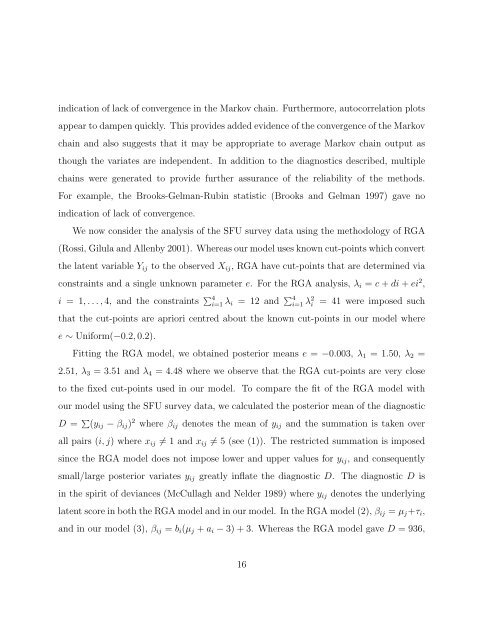Bayesian analysis of ordinal survey data using the Dirichlet process ...
Bayesian analysis of ordinal survey data using the Dirichlet process ...
Bayesian analysis of ordinal survey data using the Dirichlet process ...
Create successful ePaper yourself
Turn your PDF publications into a flip-book with our unique Google optimized e-Paper software.
indication <strong>of</strong> lack <strong>of</strong> convergence in <strong>the</strong> Markov chain. Fur<strong>the</strong>rmore, autocorrelation plotsappear to dampen quickly. This provides added evidence <strong>of</strong> <strong>the</strong> convergence <strong>of</strong> <strong>the</strong> Markovchain and also suggests that it may be appropriate to average Markov chain output asthough <strong>the</strong> variates are independent. In addition to <strong>the</strong> diagnostics described, multiplechains were generated to provide fur<strong>the</strong>r assurance <strong>of</strong> <strong>the</strong> reliability <strong>of</strong> <strong>the</strong> methods.For example, <strong>the</strong> Brooks-Gelman-Rubin statistic (Brooks and Gelman 1997) gave noindication <strong>of</strong> lack <strong>of</strong> convergence.We now consider <strong>the</strong> <strong>analysis</strong> <strong>of</strong> <strong>the</strong> SFU <strong>survey</strong> <strong>data</strong> <strong>using</strong> <strong>the</strong> methodology <strong>of</strong> RGA(Rossi, Gilula and Allenby 2001). Whereas our model uses known cut-points which convert<strong>the</strong> latent variable Y ij to <strong>the</strong> observed X ij , RGA have cut-points that are determined viaconstraints and a single unknown parameter e. For <strong>the</strong> RGA <strong>analysis</strong>, λ i = c + di + ei 2 ,i = 1, . . . , 4, and <strong>the</strong> constraints ∑ 4i=1 λ i = 12 and ∑ 4i=1 λ 2 i = 41 were imposed suchthat <strong>the</strong> cut-points are apriori centred about <strong>the</strong> known cut-points in our model wheree ∼ Uniform(−0.2, 0.2).Fitting <strong>the</strong> RGA model, we obtained posterior means e = −0.003, λ 1 = 1.50, λ 2 =2.51, λ 3 = 3.51 and λ 4 = 4.48 where we observe that <strong>the</strong> RGA cut-points are very closeto <strong>the</strong> fixed cut-points used in our model. To compare <strong>the</strong> fit <strong>of</strong> <strong>the</strong> RGA model withour model <strong>using</strong> <strong>the</strong> SFU <strong>survey</strong> <strong>data</strong>, we calculated <strong>the</strong> posterior mean <strong>of</strong> <strong>the</strong> diagnosticD = ∑ (y ij − β ij ) 2 where β ij denotes <strong>the</strong> mean <strong>of</strong> y ij and <strong>the</strong> summation is taken overall pairs (i, j) where x ij ≠ 1 and x ij ≠ 5 (see (1)). The restricted summation is imposedsince <strong>the</strong> RGA model does not impose lower and upper values for y ij , and consequentlysmall/large posterior variates y ij greatly inflate <strong>the</strong> diagnostic D. The diagnostic D isin <strong>the</strong> spirit <strong>of</strong> deviances (McCullagh and Nelder 1989) where y ij denotes <strong>the</strong> underlyinglatent score in both <strong>the</strong> RGA model and in our model. In <strong>the</strong> RGA model (2), β ij = µ j +τ i ,and in our model (3), β ij = b i (µ j + a i − 3) + 3. Whereas <strong>the</strong> RGA model gave D = 936,16
















